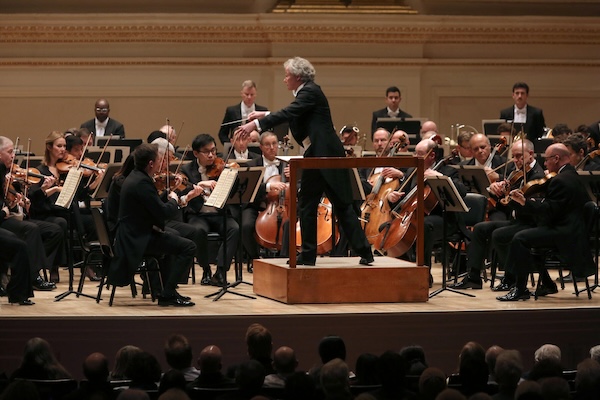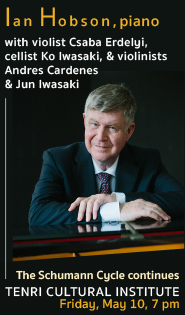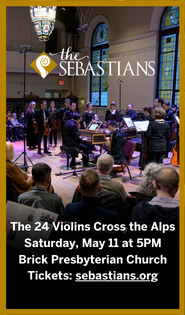Cleveland Orchestra gets into gear with Prokofiev

Just two concerts in, Carnegie Hall’s in-season festival, “Fall of the Weimar Republic: Dancing on the Precipice,” is already displaying the extraordinary breadth of stylistic ideas from the period.
Saturday night, the Cleveland Orchestra touched on some of the era’s theatrical ideas, with Krenek and Bartók. Sunday afternoon, again under conductor Franz Welser-Möst, the music was more abstract and avant-garde, with works by Prokofiev and Webern exploring what were new concepts for how—and why—to structure and form music.
The orchestra played three symphonies: Prokofiev’s Second and Fifth, and Webern’s Symphony, Op. 21. Only the first half had anything to do with Weimar; Prokofiev’s Symphony No. 5 after intermission came at the end of WWII, and at least celebrated the defeat of Nazi Germany. But on the basic levels of performance and enjoyment, this was superlative orchestral playing and terrifically musical.
The previous night, the orchestra had a cool demeanor for most of the concert. On Sunday, their playing was forceful and often thrilling from the start. Prokofiev’s Symphony No. 2 demands that. The work hails from a period when the composer was living in Paris and exposed to Western ideas. One of the major concepts of the avant-garde in the 1920s was to make music that captured the qualities of machines, especially vehicles. Predating Weimar, it was the Futurists who coined the idea that the factory was the cathedral of the modern age, and made the first industrial music; with composers like George Antheil, the idea was not to make music with machinery, but which emulated machinery.
That is Prokofiev’s Second, a pounding, exciting work that is easily his most experimental. One imagines the shock of it for its first listeners, but 100 years later, and with this exceptional ensemble, one mainly heard the composer as a genius. The structural elements worked together, but as material to achieve musical goals. Rhythms may thud and phrases my repeat, but they never stand still, and even as the second movement is a long series of variations, the whole work has the composer’s creative restlessness, a sense of constant transformation.
The performance was exacting but not ruthless. Inside a great mass of instrumental sound, one heard each small, discrete phrase, the details that not only make music interesting but that connect to each other to build sonic architecture. Prokofiev’s machines might be full of sheer power, but they are also elegant, clever, at times contemplative and sensitive. The playing was all this and more, skillful and intellectually expressive in the extreme, physical punchy, vigorous, eager to give life to the composer.
It’s easy to counter the extroversion of Prokofiev’s machinery with a cool take on Webern’s atonal structuralism, but the latter has his own warmth, and the orchestra produced that with lovely articulation of the music.
That meant fitting the composer’s puzzle pieces into place with precision, but also hearing how the basic two-note phrase is the core of this music, and how it can echo the opening of Mahler’s Symphony No. 9 if one plays it with expression, however fleeting. It was mesmerizing to hear the musicians pass this idea around among themselves, a real conversation that added thoughtfulness and meaning as it went along.
Prokoviev’s Symphony No. 5 may be post-Weimar, but it’s a wonderful work nonetheless, and clearly a staple in the orchestra’s repertoire—they released a fine live recording of it last year, and this was a scintillating performance. The sound of each section was gorgeous—one was left thinking that there could be no finer orchestral string playing. Like Webern, there was a strong feeling of the musicians listening to each other and playing together, the conductor merely there to make sure they were all together.
There was also the feeling that each passing section of the music, and each flowing mood, was played in just the right way. The music marks a victory, but it’s not triumphant—more the sense of relief after enduring hardship, a survey of what happened and how one made it through.
The Allegro marcato movement is perfect for this, and the orchestra played the opening sprint with both humor and anger, while the inner slow interlude had great beauty and repose. Welser-Möst had superb command over the overall shape, and ramped the final movement up smoothly to a careening, thrilling conclusion.
Fall of the Weimar Republic continues with the Met Orchestra Chamber Ensemble playing Hindemith, Weill, and Johann Strauss Jr, 7:30 p.m. Monday. carnegiehall.org








